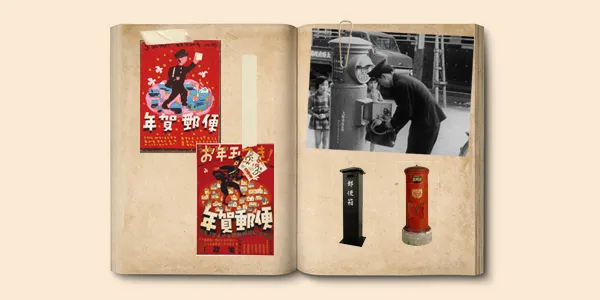The Japanese Postal Symbol and Other Amusing Mail Trivia

Here’s a truth: we tend to be equally amused and horrified at the stuff we uncover.
(Not that this trivia is in hiding—just that it tends to be in Japanese PDFs. You get the idea.)
Today, discover the origins of why Japanese post boxes are red, the guy who created the nengajo lottery, the mystery surrounding Japan’s postal symbol, Japan’s current global postal rank, and some trivia from our very own Mail office.
Get ready for some nerdy delight for your brain to chew on.
Where did the Japanese postal symbol 〒 come from?
So the official origin story goes like this: During the late 1800s, the Ministry in charge of the postal service was 逓信省 = “teishinshou.” And the phonetic kana reading of the first character is「テ」(te). So the postal symbol 〒 is said to be derived from the kana letter テ.
But actually, there’s a backstory to the official story.
It seems that Japan’s postal mark was originally going to be the letter “T” for *T*eishinshou (the Ministry of Communications).
In fact, the Ministry had published an announcement stating “T” as the postal symbol on February 8, 1887. Psst. If you want to be really nerdy about it, Google 🔎逓信省告示第11号(本省徽章ヲ創定ス)「自今 (T) 字形ヲ以テ本省全般ノ徽章トス」
However, after belated due diligence, the Ministry learned that “T” was a mark used internationally for insufficient postage. So backpedaling, they posted an “oops” retraction on February 19, 1887. Where they said something that amounted to, “Ahem. We actually meant 〒 (totally our first pick).”
So the debate boils down to whether it was initially supposed to be “T,” but an error forced their hand to go with 〒. *OR* it was always originally going to be 〒 for テ, and the first announcement was just a mistake. 🤷
In any case, since approx. 1887, the postal symbol 〒 has been worn with pride on postal uniforms, letter collection boxes, post offices, etc.

Source: Postal Museum Japan
What is Japan’s postal code?
Japan’s postal code system (郵便番号= yuubin bango) was first introduced on July 1, 1968, to facilitate postal sorting machines. Postal offices were assigned a set of 3-digit or 5-digit numbers based on railroad transportation routes, which was the main way post was transported back then.
On February 2, 1998, a 7-digit ZIP code was introduced by adding four or two digits to the end of the previous ZIP code, making it possible to designate town areas and individual housing and apartment buildings (the current system in place). Postal codes are preceded by the postal symbol and then followed by 7 digits:〒NNN-NNNN.
Here’s a directory of Japan’s postal codes and designated regions.
How do you type the Japanese postal code symbol?
To type the Japanese postal code, first type the character code “3012.” Then press ALT + X and Japan’s postal code symbol will appear.
What is Japan’s postal mark face symbol?
In 1998, the Ministry of Communications introduced a mascot character, Poston, to celebrate the switch to 7-digit zip codes. Poston’s design and nickname was chosen from public submissions. While Poston hasn’t officially retired, it’s rarely used in an official capacity by Japan Post. To make this smiling postal symbol appear (〠), type “3020” then press ALT + X.

Image. Mascot Poston, the originator of Japan’s postal mark face symbol.
Why are Japanese post boxes red?
In 3 words: “mistakes were made.”
Japan’s first mailboxes were painted black for a run of 30 years, from 1871 to 1901. But public toilets were becoming popular at the same time. The story goes that passers-by who saw the black mail boxes mistook them for toilets, misreading the sign 郵便箱 for 垂便箱.
Streetlights at night weren’t common back then, so we can see how someone in their cups might misread the sign on the mail boxes. (Not making this up.)
The switch to red mail posts came in 1901 when the color was changed from black to red to make the mail posts stand out—even at night!

Sources: Postal Museum Japan; Wikipedia
Who created Japan’s New Year’s lottery?
Since 1949, Japan’s 年賀状 New Year’s postcards list lottery numbers on each card. (You knew that right?)
The man who came up with the big idea was, in fact, a private citizen.
Much ado is made about that fact—probably cuz we all know what it’s like to walk into a Japanese office and say, “Here’s something new to try.” 😑
Anyhoo. The story goes, Masaji Hayashi traveled to Tokyo (from Osaka) to present his idea to the Ministry of Communications (the Postal HQ at the time).
In prep, he had brought with him mockup postcards and posters he had painted himself. Side note: he was an amateur watercolorist as well as being a shop owner of Western goods.
Japan being Japan, the idea didn’t take right away. But also, Japan being Japan, EVENTUALLY, some people in the Ministry were persuaded! The result: today’s nenga lottery お年玉付き年賀.
For us, this story is worth sharing mainly because the man knew how to pitch:
We looked at the mockups he prepared, and this is no walk-in-off-the-street-with-an-idea proposal. Mr. Hayashi thought of EV-RY-TH-ING.
He presented a prototype, posters to use as ads, price points, eligibility period, & ideas for the prizes. Plus, his plan targeted their fears re: a decline in postal use (for context, it was the end of World War II, and no one was having a good time).
He gave them reasons to care beyond cash: “A nation-wide lottery will lift the country’s spirits + the campaign will encourage people to get back in touch with friends and relatives separated during the war.”
Basically, he did all the hard work for them, so all t’was left for them to say was YES.
P.S.: Much of Mr. Hayashi’s play-by-play was followed, right down to his suggestion for the first-place lottery prize: a sewing machine. Also, check out the poster he included in his pitch, and then the poster the Ministry published! Pretty similar, right?

Source: Postal Museum Japan
Japan’s 2021 postal ranking: 4th out of 168
In 2021, Japan ranked 4th out of 168 countries in the Universal Postal Union's 2021 report.
Countries are measured against 4 pillars:
Reliability reflects performance in terms of speed and predictability of delivery.
Reach reflects global connectivity by evaluating the breadth and depth of the postal operators’ international network.
Relevance measures the intensity of demand for the full portfolio of postal services.
Resilience indicates the level of diversification of revenue streams, as well as the capacity to innovate and deliver inclusive postal services.
Countries with a score above 55 are among the top 20% in the world. Japan scored 90 to come in 4th place.
Who founded Japan’s postal system?
Hisoka Maejima 前島密 (1835–1919) established Japan's postal system in 1871 at the age of 36. Maejima was committed to "freedom, equality, and fairness" and resolved that all—regardless of rank—should be able to use the new postal system.
For 11 years, Maejima served as the head of postal administration, connecting Japan’s postal system to the rest of the world—and many other initiatives that still exist. Read more about this Meiji-era man who helped to modernize Japan.
Frequently asked questions
Where did the Japanese postal symbol 〒 come from?
During the late 1800s, the Ministry in charge of the postal service was 逓信省 = “teishinshou.” And the phonetic kana reading of the first character is「テ」(te). So the postal symbol 〒 is said to be derived from the kana letter テ.
How do you type the Japanese postal code symbol?
To type the Japanese postal code, first type the character code “3012.” Then press ALT + X and Japan’s postal code symbol will appear.
Why are Japanese post boxes red?
Japan’s first mailboxes were painted black for a run of 30 years, from 1871 to 1901. But public toilets were becoming popular at the same time. The story goes that passers-by who saw the black mail boxes mistook them for toilets. The switch to red mail posts came in 1901 when the color was changed from black to red to make the mail posts stand out—even at night!
Who founded Japan’s postal system?
Hisoka Maejima 前島密 (1835–1919) established Japan's postal system in 1871 at the age of 36. Maejima was committed to "freedom, equality, and fairness" and resolved that all—regardless of rank—should be able to use the new postal system.
👉 Use our Japan Postal Codes tool to help you find the postal codes for places throughout Japan!
Final thoughts
We’ll leave you with one last amusing postal story from Japan.
Related articles and guides on Japan’s postal system
Japan Post Forwarding: How to Forward Mail Online [With Pictures]
What Is a Virtual Mailbox Service in Japan? [Your FAQs Answered!]
Undeliverable Item Notice from Japan Post? Here’s What to Do
Spending too long figuring out your Japanese mail?
Virtual mail + translation services start at 3800 per month. 30-day money-back guarantee.

